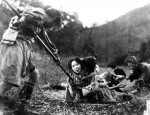Kenji Mizoguchi reflects the personal experiences of his sister’s life as a geisha and his father’s business and financial failure onto the big screen.
The UCLA Film and Television Archive is showing nine of Mizoguchi’s films from Jan. 16 to Feb. 15 at the Billy Wilder Theater in the Hammer Museum. The series opened Friday with back-to-back screenings of “Street of Shame” and “Ugetsu” and will show “Sansho the Bailiff” and “Utamaro and His Five Women” on Friday and Monday, respectively. The series will close out with a 241-minute two-part film, “The 47 Ronin.”
The original 35 mm films were borrowed from the Museum of the Moving Image in Astoria, N.Y., which held its own series from May to June last year of the 30 Mizoguchi films remaining in existence.
“If you were new to Mizoguchi, these are the films that you would need to see first … because they’re all of his major masterpieces,” said Paul Malcolm, a programmer at the UCLA Film and Television Archive.
David Schwartz, the chief curator of the Mizoguchi retrospective series at the Museum of the Moving Image, said the museum partnered with the Japan Foundation, an organization which promotes Japanese culture, to bring in and screen the film prints. He added that screenings of these films are rare because most of them are not in distribution in the U.S.
“They might have played when they came out originally in the United States, but were not kept in circulation,” Schwartz said. “So I think Mizoguchi is one of the great filmmakers whose work is not actually seen that much.”
Malcolm said Mizoguchi’s silent films are fragile and particularly rare because much of Japan’s silent film history is missing from the post-war years. Malcolm regards Mizoguchi, whose work ranges from the silent era of the 1920s to the 1950s, as one of the major international directors of all time.
“He was a brilliant thinker and he was interested in social conditions. He had a particular interest in the treatment of women in a very restrictive society, so that’s what he explored in his films,” Schwartz said.
Mizoguchi’s films subsequently involve women sacrificing happiness and their lives, Malcolm said. This sacrifice is connected with prostitution, like in “Osaka Elegy,” where a working woman becomes a mistress for her boss to save her family. The focus on geishas and prostitution is demonstrated by “Street of Shame,” “Sisters of Gion” and “Life of Oharu.”
“They end up becoming or having to become prostitutes or geishas because of the kind of options or choices that traditional feudalistic society forces upon them,” Malcolm said.
Malcolm said this inherently ties in with the overarching humanistic theme of self-worth.
“(There’s) this importance or the power of human dignity and this struggle to maintain human dignity in a world of cruelty that’s created by dictatorial men,” Malcolm said.
First-year biology student Maria Almaraz attended the Friday screening of “Ugetsu” and had never before been exposed to Japanese cinema.
“I was able to gain some insight (into Japanese culture),” Almaraz said. “It was just interesting to see how some things are universal in regards to women and the roles they play within the society (of) different cultures.”
Next to his themes, Mizoguchi is most famous for his moving camera and long takes.
“I think he is a very influential director in terms of the mobility of his camera (and) the way that he grounded his characters in a real sense of space,” Malcolm said. “He was a very meticulous composer of images.”
Malcolm said that by avoiding close-ups and utilizing the one-shot-per-scene method in wide-shot, Mizoguchi made his stories seem more realistic for the audience.
“In ‘Story of the Last Chrysanthemum,’ there are these long shots where the two lovers are walking along the riverbank and the camera just tracks along with them throughout the whole river,” Malcolm said. “You just forget how long the shot’s been going until you cut to the next scene.”
The next showing, “Sansho the Bailiff,” revolves around a son’s difficulty to reunite his family. Malcolm described it as a story about a family torn apart by fate and corruption.
“(Mizoguchi) might be something of an esoteric or acquired taste,” Malcolm said. “But once you get in and you watch (and) you’re sitting in front it, they’re just … incredibly powerful.”
